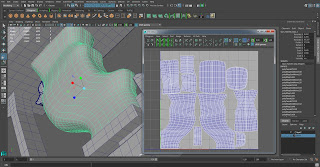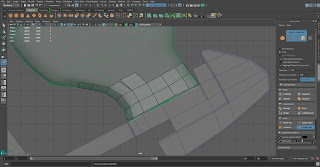As the gun I was modelling was from my own concept sketches, it was very difficult to model into 3D. To aid my construction, I made the sci-fi gun out of modelling clay as seen below.
I tried to form the gun and make it look as hard-edged as possible, while just using my hands to build the all components.
As the model is the size of a small banana in length, I had to reinforce the clay with wooden toothpicks and thin metal wires to support the individual structures and also to bond them before baking it.
Overall, this side project towards the final game asset has been a huge help towards the final vision of the gun from 2D to 3D. I was very pleased with the scale as many of the parts were close to what their size was compared to the volume when I thought them up previously.
Before finalising certain components in ZBrush, I placed the OBJ files as tools (objects) into a scene and subdivided just to see what it looked like smoothed in the software. Above, I have the model (gun base handle) at five divisions. When I eventually reached the final gun parts, I had most of them at six divisions which is around two million TotalPoints.
Here I had to sew UV's in the UV Editor to make a stream line edge to the side of the base handle panel.
I had to unwrap and layout the UV's here in the high polygon model, instead of the low polygon process, so I could extract with the 'auto-group with UV' feature. This enabled me to highlight (in selected view) an item utilising the UV face geometry.
In this image, I have placed the before and after of the divided handle grip. You can see the drastic difference of the smoothing process with the polygons from left to right.
This is a topology view of the base handle. I was really pleased with the process of this part of the gun. This is one of the reasons it is well documented; as well as to show what the stages of work are like over the model as a whole.
To give the base handle its grip texture, I added similar to the knife assignment, noise using the Surface NoiseMaker feature. After adjusting several of the slider values in practise, I masked out the area I wanted to leave smooth in the side isometric view and then applied the NoiseMaker changes.
As the ZBrush software was new to us this term, there were hundreds of complications and issues we had to independently overcome. One that seemed very obvious (although named weirdly) was the tools. At first I thought I had to load in tediously, each tool through the importer. This meant that I placed eighteen tool OBJ's into the dock but not as a sub tool.
The sub tool is a similar layering system to that of Adobe's Photoshop layers. These enable individual editable elements of the image or object. All I had to do then, after some help from our session teacher, was to append all the eighteen tool OBJ's into one ZPR tool file and place it in the scene view.
Some UV's could be unwrapped in ZBrush, such as the wire parts seen here in this image which looked not that bad overall.
When placing the entire gun model into the scene I added a metallic chrome material to it to bring it to life a bit.
Every time I divided in ZBrush, on the gun parts I wanted to texture/add surface detail too, I would have to crease the edges before in Maya.
This crease process allowed the software to understand where I wanted the hard edged/straight corners to remain after smoothing with the divide tab back in ZBrush.
After I had my high polygon gun set up in ZBrush, I carried out the excruciating task of deleting edges and vertices not needed in my low polygon model. Above is a screen capture where I was using all the functions in quad-draw to quickly and effective make a low poly form of the base handle.
Here is a selection of Alpha brushes I created in Photoshop following a similar scratch pattern to that of the one I found online (top left hand corner). I simply applied these adjusting things like the size of the brush and the intensity of pressure to the object surface in ZBrush.
This part of my gun was rather problematic and I attempted several outcomes (the one above my final after no luck separating noise placement).
What I was attempting with this section was a braided rope effect over the top of the wires; similar to what PC's have to protect external cables. I made the surface detail using the NoiseMaker feature again with the checkerboard pattern.
After what seemed like forever, I had deleted all the unnecessary edges to complete my final low polygon model at thirty three thousand, eight hundred and seventy four 'tris'.
Above is also my final ZBrush gun model with all the parts I wanted to add texture too complete.
As the weeks quickly went by, more deadlines and content for our second (Games Production) Unit was needed. As I was the concept artist for our group's game, I had to create a lot of material in a short space of time in high detail (for other members to work from). On return to my gun asset, I sensed I had fallen behind quite a fair amount.
As I panned about my low poly model's UV's in Maya, one problem turned into a hundred, as I realised there was a huge section of what I can only describe as hidden faces/edges on an earlier merged component. There was no way out of trying to get around this dilemma that had to be resolved by finding each vertices or face and either moving and merging or deleting it entirely (as I had now formed the low from the high poly model).
As seen in the previous image, I made sure to delete my history after an action as I had several points where Maya just kept crashing (due to old attribute memory). In this image, I laid out the UV's for the main stock of the gun as automatic unwrap didn't do a very good job.
One method I used to help fix n-sided faces (a massive problem that occurred later in the software xNormals) was the Cleanup tool in Maya. This tool fixes tessellations by adding in an edge to any faces with more than four sides (which I had lots of). Here the Cleanup tool is in action on the top handle of my gun which was a real drawback.
Above are the final unwrapped UV's displayed using a checkerboard preview in the Editor. While trying to get hold of the only session teacher without any success in the last week before the hand-in deadline (everyone needing one persons help), I overcame a major issue of merging down sub tools in ZBrush; with a little help from a student on the same unit. Ultimately, I had to export four separate parts, that make up my gun, as OBJ files which worked fine with the texture issue in my high poly model.
Before I unwrapped the combined petal ends correctly, as seen in the previous image, I did a test of what the normals looked like in the map baking software xNormals. Following all the steps and instructions we were taught, I instantly knew the UV layout was disarranged in the normals preview screen.
Here is my final four normal maps (without ambient occlusion) baked in xNormals. At this point, I did not worry about the really small errors in the face values of the individual parts. The main goal was to get all the stages completed. These last two stages being, to use Quixel in Photoshop (to make textures on my UV layouts) and importing the model and textures into Unreal Engine (within a scene build).
Above is a preview of the baking for an Ambient occlusion map for my assets exterior cables. The rendering wraps around the image in a clockwise rotation (halfway round in my screen capture). Because of the file size (around 4K quality), it took about twenty minutes to complete baking. I then had to do this for all four parts that make up the entire model.
Unfortunately I did not get to texture in Quixel and Photoshop. Here is a UV Snapshot of the stock of the gun asset.
These are the materials I would have placed on my gun asset model.
I formed a very basic scene in Unreal to place my gun in.
Here is the gun asset in the scene view within Unreal.
Finally I cropped a screen capture of my gun with the lighting and shadow depth quality at production standard. Overall, this Unit has challenged me constantly and I have enjoyed so many aspects as a whole. In addition, I would love to continue to complete my textured model in the future as well as animate the original arcing firing mode.


































No comments:
Post a Comment